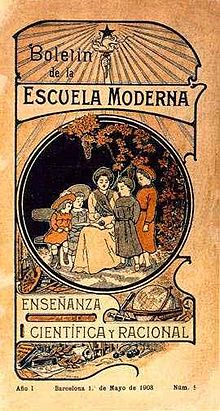Escuela Moderna
The Modern School ( Spanish Escuela Moderna ) by Francisco Ferrer is considered to be one of the most important theoretical and practical reform models of rationalist and libertarian education.
Social conditions
The social conditions in Spain around 1900 were a challenge for reform pedagogy at the turn of the century. The economic structure was poorly developed and mainly characterized by agriculture. Politically, there was close ties between the church and the monarchy . Despite compulsory schooling since 1857, the illiteracy rate was over 50% because neither the state nor the church (the church was in charge of the school system) paid enough attention to educational initiatives. In elementary schools, instead of learning to read, children had to recite the catechism by heart.
Theoretical foundations
Ferrer's model was based on the philosophy of rationalism and libertarian socialism. Based on the assumption that the child is born without innate ideas, he saw it as the task of the educator to encourage the child to think independently and without prejudice. All people should have the same education and upbringing. For Ferrer, body and spirit, mind and feeling were a unit. In his opinion, a separation of mind and feeling were the cause of the contradiction between thinking and doing. He saw friendship and affirmation of the child by the educator as a prerequisite for a healthy personality development, as did non-violence.
Educational goal
In his book The Modern School , Ferrer described his educational goal as follows: “To develop living brains capable of reacting to external impressions that will always be enemies of all prejudice; Awakening of free, firmly established spirits who can form their own opinion about all things and phenomena in life. "
He believed that liberally and scientifically educated people strive to create a state of society that ensures life its greatest possible development. In Ferrer's view, with increasing industrialization it was no longer possible for the state and the church to keep the people in ignorance.
School organization
In order to be able to achieve his educational goal, the training of teachers in the principles of rationalistic pedagogy was of central importance for Ferrer, according to his principle: " Be a person, because you should create people ." For the health education of the students he improved the hygienic conditions the school and introduced the empathy game to school lessons. Social education included co-education of the sexes and social classes and the rejection of the use of reward, punishment and exams as a means of education, which was revolutionary for the conditions at the time. In order to be able to realize his ideas of a rational intellectual education, Ferrer had to develop new textbooks himself or commission them to scientific writers. 40 works were published by the modern school's book publishing house.
In order to give the population, family members of his pupils and workers eager to learn the possibility of education in the sense of the modern school, Ferrer organized public Sunday lectures, published a newsletter and maintained a rationalist public library. The bulletin also served as a means of correcting exuberant or defamatory articles in the press.
Spread of the Modern School
On September 8, 1901, Francisco Ferrer opened the first modern school with 12 girls and 18 boys under the name La Escuela Moderna, Científica i Racional . The theory and practice of the modern school proved its worth in the steadily increasing number of pupils and the spread of this school model in Spain and worldwide. In 1903 there were 32 schools of this type in Spain and in 1906 there were already 60 such schools. In 1907 Ferrer founded the "International League for the Reasonable Education of Young People" in Paris. After the tragic week and Ferrer's execution, the Spanish government banned the Escuela Moderna. By World War II, Modern Schools were established across Europe, Russia, Argentina, Brazil, USA, Japan and China.
The Escuela libre Paideia near Mérida (Spain) relates pedagogically to Francisco Ferrer and sees itself in the tradition of (Spanish) anarchism. The Democratic School was opened by Josefa Martín Luengo in 1978 and still exists today as a primary school and all-day school, and since 2007 at the latest a secondary school and a kindergarten have been connected. Paideia grew from 10 to 58 students in 2007.
Graduates of the American Ferrer Schools were involved in the establishment of free schools during the so-called Free School Movement in the USA in the 1960s.
literature
- Francisco Ferrer: The Modern School . Edition AV Verlag 2003, ISBN 3-936049-21-1
- Pierre Ramus : Francisco Ferrer - The Modern School . Meppen / Ems 1979.
Web links
Individual evidence
- ↑ Freie Arbeiter und Arbeiterinnen Union (ed.): Paideia - School of Anarchy. Available online , last checked on June 25, 2019.
- ↑ Kathlyn Gay, Martin K. Gay: Encyclopedia of Political Anarchy . ABC-Clio, Santa Barbara 1999, ISBN 0-87436-982-7 , pp. 146 .
